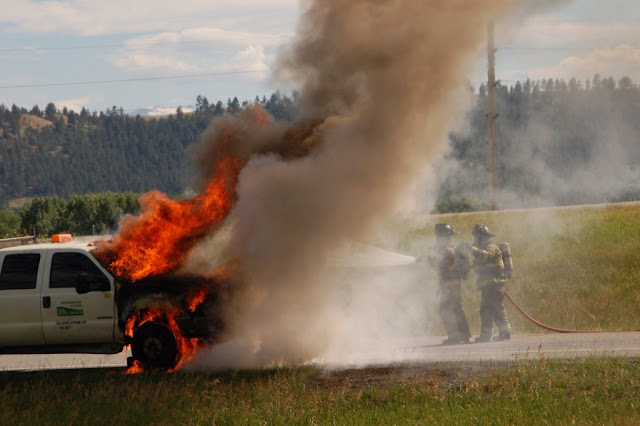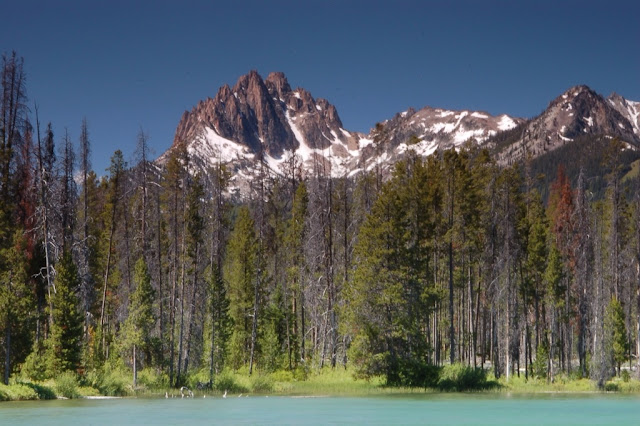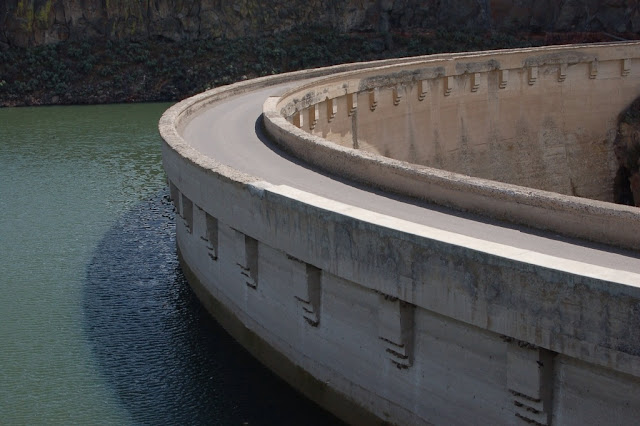Again yesterday, the temperature hit 100 degrees. We are prompted to keep driving as at least while moving we can operate the cabin air conditioner. Across Montana we drove, following the swollen Yellowstone River. As it moved east, we could see it getting bigger and bigger, even with the draw down for the surrounding farms. At the wide sweeping curves in the water way, there are still large standing waves, something I would think normally by this time of year would be placid turns in a lazy flow. What appears now to be mid-stream, are probably submerged and swamped islands holding fast to one or two sturdy cottonwood trees, the rest of the surrounding grasses and willows lost to the raging waters.
It is easy to be lulled into complacency, and just stare ahead at the two lanes of asphalt ribbon leading off ahead, but as a passenger I have the liberty to see the bigger picture, how the roadway plays only a part of the overall landscape, and how the real dominate feature here is the wide Yellowstone river bottom and flood plain, not the four lane interstate and associated commercial signage clutter which has adopted this relatively wide and flat corridor as its resting place. A mile off to each side, a variegated escarpment climbs and layers of shattered rock are exposed to the elements. Above the escarpment, the plains roll off in a variety of sized hills, some hundreds of feet over the others. In the defiles between bumps, eroded stream beds carve narrow sinuous gorges that all lead down to this wide plain of the Yellowstone River.
No contrails litter the blue sky, but towering thunderheads scuttle by mixed with a high cirrus and a mackerel middle layer of clouds reaching overhead in a continuous dome of sky. This is truly the Big Sky country, with no major mountain ranges obscuring the view for what must be hundreds of miles in all directions. The massive hay cutters and bailers look like toy trucks when seen in the context of these rolling open spaces, with the farmers operating the equipment barely visible, however evident their hand is upon the landscape. The herds of cattle are growing larger, as is the size of the irrigated fields as the plain begins to iron out its folds and to lay down smoothly as we move east.
By early afternoon yesterday we passed into North Dakota as the badlands seem to rise all around us. Now the plain is broken again, this time by undulating rolling hills of ancient rock, some hundreds of feet high, some only 10 feet high. We have left the clarity of the drainage of the Yellowstone and now cross many rivers traveling in confused paths in all directions. On the north sides of these steep defiles stunted juniper cling to the hillsides, where on the south exposed sides only a wild mix of prairie grasses can persist. These lands are the eroded remains of a lifted and folded ancient seabed and stretch from here in North Dakota all the way down to the parched canyons lands that dominate the eastern Rocky Mountainn foothills in many states to our south.
We pull into Theodore Roosevelt National Park around 3:00pm and camp by the wide waterway of the Little Missouri River. Clearly often flooding here has pushed the surviving mature cottonwood trees far from the current river's edge. We are camped in a copse of mature trees, now shedding their namesake puffy cottonball like pollen bundles to the wind like a light snow flurry. White tail deer are dining unfettered between us and the river in the swampy high grass that has been recently watered by these spring floods. One quarter mile away, across the river one of the many badlands hills rise and show us waving fields of tall grasses flowing in the strong wind as if under a clear boundary of water moving first one way, then the next.
In the late afternoon we begin a slow 30 mile scenic drive, which is the most common way people experience this park. We are hoping to see wildlife and grand landscapes as the sun sets. The billowing clouds have begun to pile up and rain is clearly visible as heavy sheets in the distance. It is not long before we come upon a band of wild horses all shaking their heads in a similar fashion we suspect serving to keep flies from their eyes. They have long bangs that hang over their foreheads and faces which they swish back and forth to keep their eyes clear of the nagging insects. There are obvious family groupings as the colored markings on mother, yearly, and new colt show them to be part of the same genetic set. The horses are familiar with slow moving cars so seem unfettered in their pursuit of evening's forage so close to the roadway. We stop for a while to observe then move on.
After not too much longer we come upon a singular massive male bison. Amazing we think and crane our necks to get a better look. Pushing onward we then come upon a recling set of similar animals in the shade of a hillside. Then, around the next corner we are overwhelmed, literally, by a herd of bison of all sizes milling about on both sides of the road and right up the middle. The park guide says there are over 400 animals in the park. We suspect this is at least 1/3 of the overall herd. We are stopped because the animals are blocking the road. The massive males, with shoulder humps as high as six feet and small beaty eyes clearly taking in the surroundings of other animals, cars, and grass opportunities are in control of the movement of the herd. The large males linger behind the bulk of the herd, urging them forward with low guttural grunts that sound like far away thunder or the grinding of large rocks along the bottom of a river in high flow stage. In many cases they stay close to one particular female, keeping the other males from getting close. The calfs linger directly underfoot, sitting often in the slow parade while the yearlings stand off to the side, or follow just behind and are reminded with a showy pawing of the dusty soil or an especially loud snorting vocalization to stand down when they get too close to the dominant males. The herd has selected to move mostly down the roadway up and over this low pass, so we are gifted with the opportunity to watch the group dynamics of this slow parade for almost an hour. Actually, we have no choice, as other park visitors have arrived behind us and block our retreat, and the dusty, clomping, snorting mob of bison block any movement forward. We have a grand perch, high in our front seats to see and watch all the action. The one car in front of us is a small sedan, whose passengers sit well below the eye level of most of the animals. They are intimidated and are often the focus of the driving animals. These beasts place themselves directly in front of the most forward car and stand firm while their family group passes thusly guarded in front of the intruders. Only after well clear of the car does the steaming animal begin to slowly move on, often straight forward to begin the stand-off once again a few paces down the road.
Eveventually, the herd gives way as they fan out to wider pasture, and we move ahead into the awaiting arms of a monstrous thunder and lightening storm ravaging the badlands all around us. The national weather service warns us on the crackly radio of quarter sized hail and strong wind gusts - urging people into places of shelter. We retreat to our sheltered cottonwood campsite on the shores of the Little Misourri river and watch as the heavy rain pelts to windows and skylights. The front passes quickly, and soon we can open all the windows again and let the evening breezes flow through as dinner preparations get underway.














